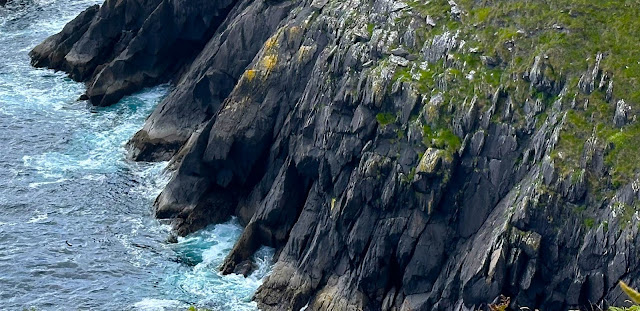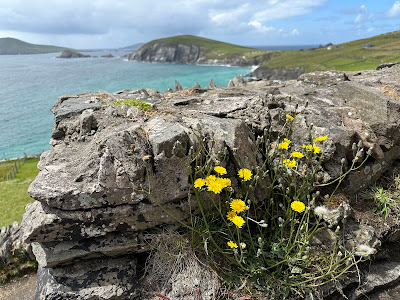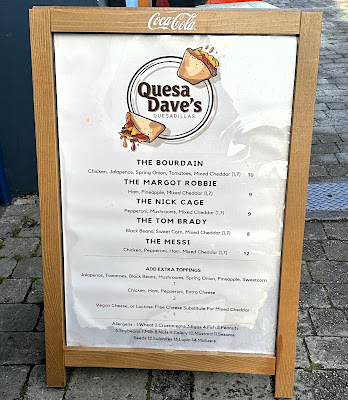July 6, 2024
Our plan had been to start the day at Blarney Castle, but when we tried to get tickets online, they were sold out. That's okay--we didn't feel a great need to kiss the Blarney Stone and taking one thing off the schedule made for a more relaxed day.
We left the B&B at about 9:30 or 10:00 and headed west towards the Dingle Peninsula.
Our first stop on the Dingle Peninsula was Minard Castle.
To get there from the main road, we drove down a very narrow single-lane road. Every now and then there was a turnout so two cars could pass, but in most spots even our tiny car seemed to hug both sides of the road, and if two cars meet in an area like this, they both have to pull over into the weeds in order to pass.
. . . that looks over a desolate bay of the cold Irish Sea.
Another place that looks like a movie set! It is nice to see a remote site like this one with no graffiti and no trash.
We resumed out Dingle journey, but we did have to stop a few times to say hello to the blackface sheep, their tiny heads poking through massive amounts of soft wool, a spray-painted mark sitting as a brand on their back. I love sheep.
The wildflowers also had their own siren song.
Shortly after we started on the scenic drive along the coastline, we came upon a sign pointing to "Prehistoric Beehive Huts." Curious, we pulled over, paid a fee of €3 each, and started up a hill towards some rock structures.
As we got further up the hill, we got a better view of the surrounding landscape and the unique vegetation.
We arrived at the first of several huts built sometime between the 8th and 12th centuries (although this type of structure existed in Ireland as early as 4,000 years ago). Most of the ones we saw did not have an intact roof, but one did, and the complete structure with its rounded roof looks like a beehive. Some are slightly rectangular, as the one below, and some may have had a thatched roof rather than a stone one. These are "restored" huts--not 100% original.
Several huts were built close together and had a surrounding stone wall.
At one time, probably at least the 12th century, hermit monks lived in the huts, and a cross scratched into a slab is evidence of Christianity.
We can only imagine what living in one of these stone huts was like over a thousand years ago, but like so many of the places we visited in Ireland, this place lends itself to legends and storytelling.
On our way back to the car, we saw a man training six dogs to herd a flock of sheep. I took a video, but for some reason I can't get it to load. It was fascinating to watch, and I noted that at least four of the six dogs looked like Pepper, the black and white dog my family owned when I was a child. It dawned on me that Pepper must have been a sheep dog. (My dad had a sheep farm when we got Pepper.)
Back in our car, we continued our moseying along the oh-so-scenic Slea Head Drive, stopping occasionally at a turnout to ooh and aah.
Close-up of the jewel colors--sapphire, onyx, emerald, and gold.
Moving along the Wild Atlantic Way loop in a clockwise direction, there were nearly perpendicular cliffs on our right . . .
. . . and the toes of those cliffs were cooling in the foamy sea:
Some of the local residents get their feathers ruffled over all of the tourists.
Not much further down the road we stopped to look at a white crucifixion scene set against a backdrop of craggy black rock. A bloody stream of red flows down one of Jesus's legs. I'm not sure if that is rust or paint.
I was fascinated by the changing tones of the ocean:
As I frequently note, I love sheep. It was fun to see a flock grazing in this rich setting.
Being in Ireland in July, we were expecting to encounter lots of buses on the scenic Slea Head Drive, but there were surprisingly few.
Also be on the lookout for this little shack.
It was an okay brownie, but not the Best I've Ever Had.
There is a substantial cemetery nearby, and I began to wonder what populates it. Is it the narrow, winding road? The surfing? The cliffs and drop offs? The brownies?
More emerald green farmland.
We stopped for a bathroom break at what appears to be close to the westernmost point of Ireland: Buaicphointí. (That's a lotta vowels.)
The Blasket Center Museum is situated on the point, and while we did not pay the admission fee to go inside, we did enjoy the curved stained glass in the entry . . .
. . . and these five exuberantly dancing figures next to the sidewalk . . .
. . . and the It-Never-Gets-Old view:
We passed "Quesa Dave's," a cosmopolitan pseudo-Mexican joint that references famous Hollywood and sports figures in its menu.
Bob had scouted out a restaurant ahead of time: Solas, one of the "100 Best Restaurants in Ireland."
Bob ordered four tapas. Top row: Bluefin tuna tartare with sesame and seaweed; crisp confit spuds with aioli and manchego cheese.
Second row: Pork belly with carrot ketchup, peanuts and sesame; grilled harbor hake with roasted peppers and tomatoes and pesto.
After dinner we drove 30 or 40 minutes to our next B&B: Murphy's Farmhouse near the tiny village of Castlemaine, population 177.












































































(Bob) I enjoyed the Dingle Peninsula, but found I actually liked the Kerry Way better, probably your next post. One of my favorite places on the peninsula was Minard Castle and it was in a movie, "Ryan's Daughter." It was fun because it was isolated, down a long and narrow road. Another favorite was the area where the ferry goes out to the Blasket Islands. However, it was raining and windy, so we didn't really have a chance to explore it. That was near the place that sold the brownies. It goes down a steep circular road and the ferry comes in among steep cliffs.
ReplyDelete